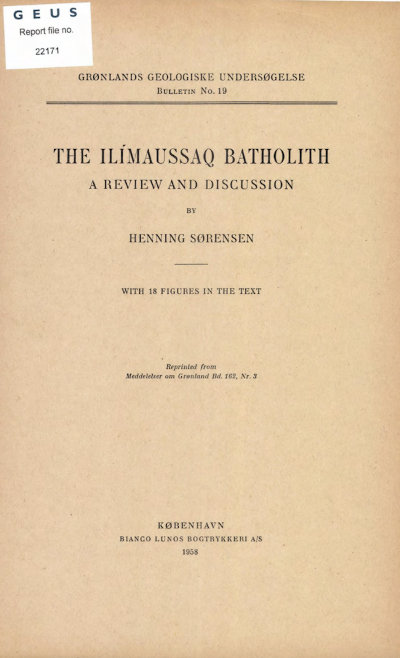The Ilímaussaq batholith. A review and discussion
DOI:
https://doi.org/10.34194/bullggu.v19.6552Abstract
The Ilímaussaq batholith was examined and described in a masterly way by N.V. Ussing in the first years of this century. During the last few years, the region has been re-examined and this work is still being carried out. It is based on maps far superior to those used by Ussing. This paper is a summary of the present knowledge of the geology of the batholith. Ilímaussaq is one of many plutonic bodies in the alkaline province of South Greenland. Its formation was preceded by the accumulation of sandstone, extrusion of lavas, and block movements. The country rock consists of granite. Ussing divided the plutonic rocks of Ilímaussaq into two groups: 1) the unstratified complex made up of fairly normal rocks as augite syenite, essexite, nordmarkite, and arfvedsonite granite ; 2) the stratified, peralkaline, agpaitic nepheline syenites: sodalite foyaite, naujaite, kakortokite, and lujavrite. These rocks are often rich in sodalite and eudialyte. The marginal borders of the batholith are transgressive. The agpaites are overlain by almost horizontal beds of porphyries. The stratified part of the complex is saucer-shaped. According to Ussing the batholith was formed in two stages; in the first stage the unstratified rocks crystallized, in the second the agpaites were intruded and partially replaced the unstratified rocks. The differentiation of the agpaites has later been discussed by Fersman and Backlund. Wegmann considered the nepheline syenites to be of metasomatic origin. The Ilímaussaq batholith is compared with other regions of alkaline rocks. On this basis and in the light of new field data the magmatic and metasomatic modes of formation of the batholith are discussed. Much more field work is, however, still necessary before more final conclusions can be reached. In addition to Ussing’s interpretation of the genesis of the batholith a somewhat different magmatic explanation is put forward. Augite syenite is considered to be the primary magma. A part of this magma was trapped under an impermeable roof and huge amounts of volatiles were accumulated in the magma during its crystallization, especially in its upper part (cf. Sather, 45). The sodalite-rich naujaite crystallized in the upper part of the magma, the banded kakortokite at a deeper level. In a later phase, subsidence of parts of the batholith occurred and at this stage the melanocratic and schistose lujavrite was formed. This rock can be compared with tinguaites and may then be considered to be magmatic, but it may also be regarded as a metasomatic rock especially formed in the most deformed parts of the complex. Wegmann’s view that essexite, nordmarkite and porphyries are metasomatically transformed into nepheline syenites is discussed. It is supported by the finding of a pillow structure in the lujavrite. As an alternative the writer suggests that the metasomatism has acted upon an older plutonic body made up of augite syenite and foyaite, etc. In the writer's opinion the combination of magmatic and metasomatic processes is in best agreement with the field observations.
Downloads
Published
Issue
Section
License
This article is distributed under a CC-BY 4.0 licence, permitting free redistribution and reproduction for any purpose, even commercial, provided proper citation of the original work. Author(s) retain copyright over the article contents.


